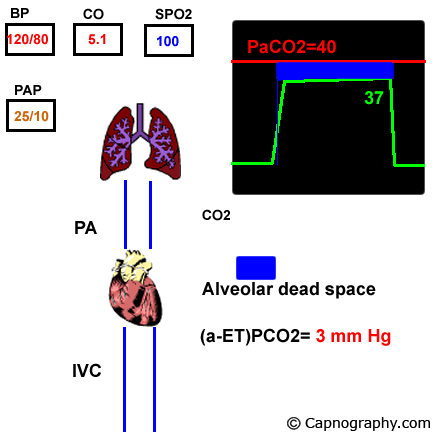Clinical Aspects
Pulmonary thrombo-embolism
Pulmonary thrombo-embolism is also associated with a decrease in PETCO2 as is in pulmonary air embolism. Breen et al,1 in an animal study, found that PETCO2 decreases when right pulmonary artery (RPA) was occluded in anesthetized, ventilated, thoracotomized dogs. By 1 min after RPA occlusion, CO2 volume exhaled per breath decreased from 9.3(2.8) to 7(2.6) ml and end-tidal CO2 decreased from 28.7(4.2) to 21.8(3.3) mm Hg. During the ensuing 70 min, VCO2/breath increased back to baseline but PETCO2 was still 13% less than baseline. Both PaCO2 (41.5(1.7) to 55.1(8.1) mm Hg) and PvCO2 (48.2(1.9) to 62.8(6.5) mm Hg) steadily increased and approached equilibrium by 45 min of RPA occlusion. Cardiac output did not significantly change. The increased PaCO2 was not detected by PETCO2 which remained decreased due to increased alveolar dead space consequent to RPA occlusion. Breen et al2 further showed in another study that intraoperative monitoring PETCO2 can be used to monitor resolution of pulmonary embolus. Resolution of embolus results in progressive increases in PETCO2 measurements.

1. Breen PH, Mazumdar B, Skinner SC. How does experimental pulmonary embolism decerase CO2 elimination? Respir Physiol 1996;105(3):217-24.
2. Breen PH, Mazumdar B, Skinner SC. Carbon dioxide elimination measures resolution of experimental pulmonary embolus in dogs. Anesth Analg 1996;83(2):247-53.

 Twitter
Twitter Youtube
Youtube









